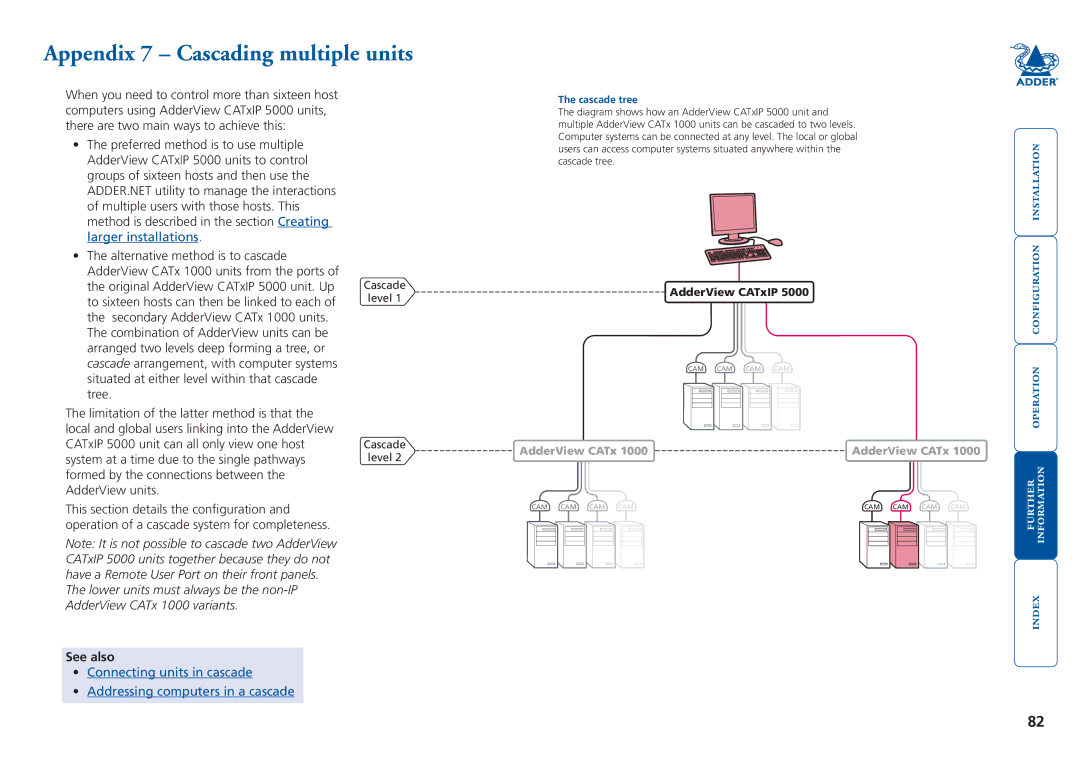AdderView CATxIP
Contents
Further information
Index
Many computers
CAM formats
Enterprise installations
Creating larger installations
Cascade installations
AdderView CATxIP 5000 features front and rear
What’s in the box
What you may additionally need
Double unit rack brackets
Mounting
Single unit rack brackets
Connections
From video monitor From USB keyboard and mouse
Local user
To connect the local user port
AdderView CATxIP Rear panel
AdderView CATxIP Front panel
Global users IP network port
To connect the IP network port for global users
To connect a computer system
Computer system via CAM
Output lead from Power adapter
Power in connection
To connect the power supply
Switch
Power control port
To connect and address the switch boxes
Multiple video head connections
Cable from serial Control device
Remote switching control
Host computer port/channel
Overall initial configuration
Configuration
Initial configuration
Security
Main menu
Menu layout
Hotkeys
Registering users and host computers
General security and configuration steps
To enable general security
To set an Admin password
To clear a password and restore factory default settings
What to do if the Admin password has been forgotten
To clear IP access control
Clearing IP access control
What is IP access control?
To configure the unit from a global user location
Full configuration by global user
Viewer encryption settings
Encryption settings
AdderView CATxIP 5000 encryption settings
Positioning AdderView CATxIP 5000 in the network
Networking issues
Firewall/router address
Port settings
Placing AdderView CATxIP 5000 behind a router or firewall
Addressing
DNS addressing
To discover a DHCP-allocated IP address
Ports
Placing AdderView CATxIP 5000 alongside the firewall
Ensuring sufficient security
To control two or more ports simultaneously
Power switching configuration
Power control sequences
To configure the power sequences for each host computer
Upgrading AdderView CATxIP 5000 models
Recovering from a failed upgrade
To upgrade AdderView CATxIP 5000 models
To invoke backup/recovery mode
Front panel indicators
Accessing the AdderView CATxIP
Selecting a computer
Local user access
Select Host menu here you can select computers by name
To select a computer using the Select Host menu
When choosing
Standard hotkeys
Logging in and out
Show All Users
User preferences and functions
To enable/disable the confirmation box
Confirmation status box
Orange dot indicators in the Select Host menu
How do multiple users coexist?
Global user access
What will I see when I first login?
Options button
Global user access via VNC viewer
To access via the VNC viewer
To download the VNC viewer
To access via your web browser
Global user access via web browser
Menu bar
Using the viewer window
When using the viewer window
To select a host
Configure
Mouse pointers
Host selection
Re-synchronise mouse
Access mode shared/private
Power switching
Auto calibrate
Controls
Keyboard Control
Enable Sun Translation
When entering codes
Video Settings
Screen contains only host system information
Using automatic configurations
Increased by 50% when a slow link is detected
Setting the Threshold manually
Reduced Blanking
Advanced Video Settings
Show All Users
Custom Video Modes
VNC hotkey selection
Supported web browsers
Viewer encryption settings
If you need to enter a port number
US +1 888 275
Troubleshooting
When logging on using VNC viewer, I cannot enter a username
Getting assistance
To access the local setup menus
Appendix 1 Local setup menus
Functions
Power Control
Restore Standard Mouse
Restore Intellimouse
Screen Saver
Settings Blank, Moving Logo
Settings Disabled, Enabled
User Preferences
OSD Dwell Time
Mouse Switching
User Timeout
Global Preferences
Auto Logout
Setup Options
Logon Security
IP address, net mask, VNC port, etc
Configuration
IP admin password, encryption settings, etc
Completely resets the AdderView CATxIP 5000 unit
Unit Configuration
Network Configuration
Options Port
Serial Configuration
Settings Power Control, Sync Units
Settings 1200, 2400, 4800, 9600, 19200, 38400, 57600
To reset the AdderView CATxIP 5000 configuration
Reset Configuration
Main configuration Logged on users
Appendix 2 Configuration pages via viewer
To access the remote configuration pages
User accounts
Unit configuration
Advanced unit configuration
Time & date configuration
IP Gateway
Network configuration
IP Access Control
IP Network Mask
To edit/remove access control entries
Setting IP access control
To define a new IP access control entry
To reorder access control entries
Baud Rate
Serial port configuration
Options Port Use
Sort
Host configuration
Erase Host Configuration
Add entry for unrecognised host
For further details To get here
Logging and status
To copy and paste the log
Syslog Server IP Address
Ldap configuration
Preferred encoding
Appendix 3 VNC viewer connection options
Colour/Encoding
Auto select
Customise
Enable all inputs
Disable all inputs view-only mode
Inputs
Misc
Custom Size
Scaling
No Scaling
Scale to Window Size
Load / Save
Defaults Reload
Defaults Save
Identities
Appendix 4 VNC viewer window options
Security
Appendix 5 Browser viewer options
Encoding and colour level
Net masks
Appendix 6 Addresses, masks and ports
IP addresses
Binary octet after
Net masks the binary explanation
Operation with net mask
Binary equivalent
Address ranges
Calculating the mask for IP access control
Single locations
All locations
Ports
Security issues with ports
Cascade tree
Appendix 7 Cascading multiple units
See also
To connect units in cascade
Connecting units in cascade
Tips for successful cascading
Addressing computers in a cascade
Using cascaded computers
Multi-head synchronisation cable
Appendix 8 Cable and connector specifications
AdderView CATxIP 5000 to power switch cable
Power switch to power switch daisy chain cable
Creating macro sequences
Appendix 9 Hotkey sequence codes
Permissible key presses
Appendix 10 Supported video modes
General Public License Linux
Warranty
Safety information
End user licence agreement
Canadian Department of Communications RFI statement
Radio Frequency Energy
European EMC directive 89/336/EEC
FCC Compliance Statement United States
Hoe Huat Industrial Building
Index
Options port Upgrade failure Connection Baud rate

